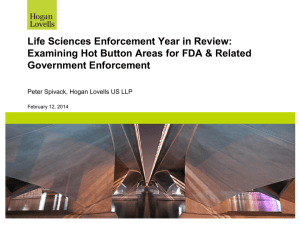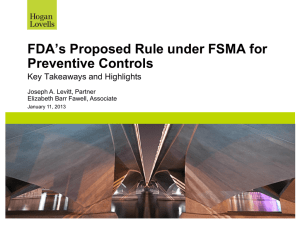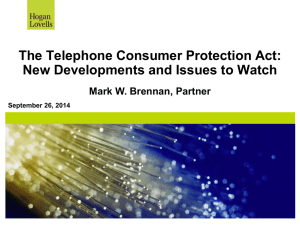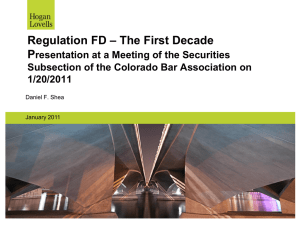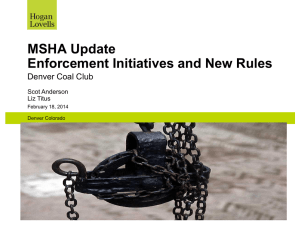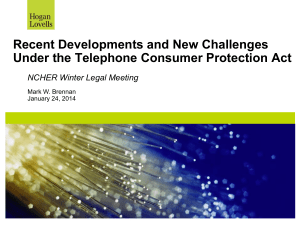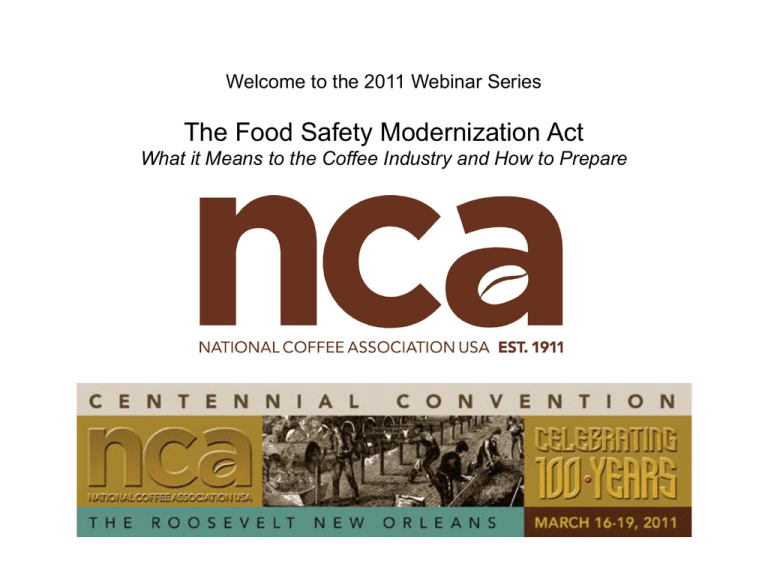
Welcome to the 2011 Webinar Series
The Food Safety Modernization Act
What it Means to the Coffee Industry and How to Prepare
FDA Food Safety Modernization Act
What it Means to the Coffee Industry and How to Prepare
Gary Jay Kushner, Partner
Elizabeth Barr Fawell, Associate
February 8, 2011
Agenda
• How we got here
• Overview:
1. New Responsibilities for Food Companies
2. New Controls on Imports
3. New or Enhanced FDA Enforcement Powers
4. New Fees on Food Companies and Importers
• Implementation Timeline
• How to start preparing today
• Practical lessons from other HACCP programs
www.hoganlovells.com
3
How We Got Here
• Series of high profile food safety
outbreaks
• Food safety standards in the FFDCA
date back to 1906
• Strong support from the
Obama Administration
www.hoganlovells.com
4
Legislative History
• July 2009, the U.S. House of
Representatives passed H.R.
2749, the Food Safety
Enhancement Act of 2009
• November 2009, Senate HELP
Committee passed S. 510, the
FDA Food Safety Modernization
Act
• December 2010, Senate and
House pass S. 510 equivalent as
H.R. 2751
• January 4, 2011, President signs
bill into law
www.hoganlovells.com
5
Passage Was Never Certain
•
Senate Votes for FDA Food Safety Overhaul, ABC News, Dec. 1, 2010
•
Constitutional provision jeopardizes sweeping food safety bill, Washington
Post, Dec. 2, 2010
•
Democrats attempt to revive food safety bill, Assoc. Press, Dec. 8, 2010
•
Senate May Clear Path to Food Safety This Week, Food Safety News, Dec.
14, 2010
•
Food Safety Bill in Doubt After Budget Concession, Food Safety News, Dec.
17, 2010
•
Senate Passes Food Safety Bill, Washington Post, Dec. 20, 2010
•
House Passes Overhaul of Food Laws, New York Times, Dec. 22, 2010
www.hoganlovells.com
6
Main Elements of New Law
1. New Responsibilities for Food Companies
2. New Controls over Imported Food
3. New Powers for the FDA
4. New Fees on Food Companies and Importers
www.hoganlovells.com
7
Coffee Industry Players
•
•
•
•
•
•
Farms/producers
Mills
Exporters
Importers
Roasters
Retailers
www.hoganlovells.com
8
Key Issues for the Coffee Industry
•
•
•
•
Requirements triggered by registration
Requirements apply to foreign facilities
Exemptions for raw agricultural commodities
Emphasis on imports
www.hoganlovells.com
9
1. New Responsibilities for Food Companies
• Affecting daily operations
– Food Safety Plans/Preventive Controls
– Supply Chain Management
– Records Maintenance and Access
– Food Defense Plans
• Applies to all Registered Facilities
www.hoganlovells.com
10
Hazard Analysis and Preventive Controls
• Conduct analysis of hazards reasonably likely to occur
• Establish controls to significantly reduce or prevent
those hazards
• Implement preventive controls through monitoring,
corrective actions, and verification activities
• Verification activities include environmental and finished
product testing
• Reanalysis required every 3 years
• Food safety plan and related records available to FDA
during inspection
www.hoganlovells.com
11
Types of Controls Defined
• Sanitation for food contact surfaces and utensils,
including food contact surfaces of equipment
• Supervisor, manager, and employee training
• Environmental monitoring program
• Food allergen control program
• Recall plan
• Current Good Manufacturing Practices
• Supplier verification activities that relate to the
safety of food
www.hoganlovells.com
12
Exemptions
• Deemed compliance for seafood HACCP, juice
HACCP, and Low Acid Canned Food facilities
• Limited exemption for very small businesses with
sales less than $500,000, where majority of food is
distributed directly to consumers or restaurants, and
distribution is intrastate or within 275 mile radius
• FDA has authority to modify rules or exempt
– Warehouses for packaged food
– Storage facilities for raw agricultural commodities
– Animal food or feed
www.hoganlovells.com
13
Intentionally Introduced Hazards
• Hazards that may be introduced by acts of terrorism
included in hazards analysis
• “Reasonably foreseeable standard” does NOT apply
• Implement appropriate mitigation steps
• FDA to issue regulations
www.hoganlovells.com
14
Not To Be Forgotten
•
•
•
•
Bi-annual registration
Safety standards for fruits and vegetables
Traceability
Records access under Bioterrorism Act
www.hoganlovells.com
15
Traceability
• Limited to “high risk” foods
• FDA to conduct pilot projects, gather additional data, assess
the cost and benefits and feasibility, and consider
international systems
• May not prescribe the use of specific technologies or require
creation of duplicate records
• May not require “full pedigree”
• Exemption for “commingled raw agricultural commodities”
• FDA has access to farm distribution information in case of an
outbreak
• FDA to propose regulations within 2 years
www.hoganlovells.com
16
2. New Controls Over Imported Food
• Supply chain verification procedures
• Foreign facilities subject to all the same requirements as
U.S-based facilities
• FDA authority to require third party certification for food
safety-related reason
• Accredited laboratory must be used for certain testing
• Expedited entry at border if safety and security guidelines
met
www.hoganlovells.com
17
3. New or Enhanced Enforcement Powers for FDA
• Increased inspection frequency
– High Risk Domestic – every 3 years
– Low Risk Domestic – every 5 years
– Ramp up Foreign inspections
(600 to 9,600 over 5 years)
• Suspension of registration
• Mandatory recall
• Expanded administrative detention
authority
www.hoganlovells.com
18
4. New Fees on Food Companies and Importers
• Reimbursement to FDA
– Reinspections
– Recall (very limited)
• Export certificates
• Fast lane for imports
• Note that reinspection
fees and export certificate
fees may start in 2011
www.hoganlovells.com
19
Items of Focus for the Coffee Industry
• Seek exemption from preventive controls for the
storage of raw agricultural commodities;
warehouses for packaged goods
• Supply chain management
– Know suppliers
– Assure customers
– Minimize duplicative audits
www.hoganlovells.com
20
Provisions NO LONGER in Bill
•
•
•
•
•
•
•
•
•
•
Registration Fees
Civil Money Penalties
Increased Criminal Penalties
Quarantine Authority
Subpoena Authority
Reports of Finished Product
Testing
Remote Access to Records by
FDA
“Full Pedigree” Traceability
Country-of-Origin Labeling
BPA
www.hoganlovells.com
21
Implementation Timetable
• Various effective dates for different provisions
• Longer implementation time for small and very small businesses
• Basic timeline
– 18 months – food safety plans
– 24 months – foreign supplier
verification
– Longer for traceability
– Bi-annual registration begins 2012
• Detailed schedule for FDA regulations
and guidance
• Law takes effect even if regulations not completed
www.hoganlovells.com
22
Implementation Timetable
• Provisions immediately effective
– Mandatory Recall
– Records Access under Bioterrorism Law
www.hoganlovells.com
23
How to Prepare: Items for immediate focus
– Food Safety Plans (and Food Defense Plans)
• Hazard analysis
• Preventive controls
• Verification, including testing
– Supply chain management
• Domestic
• Foreign
– Records maintenance and access
• Routine
• Under Bioterrorism Act
www.hoganlovells.com
24
Food Safety Plans – 5 Key Steps
Five main statutory requirements for food safety plans:
• Hazard Analysis
• Preventive Controls
• Monitoring of Effectiveness
• Corrective Actions
• Verification
www.hoganlovells.com
25
Food Safety Plans – Hazard Analysis
For hazards that may occur naturally or may be unintentionally
introduced, identify and evaluate known or reasonably
foreseeable hazards that may be associated with the facility:
•
•
•
•
•
•
Biological
Chemical
Physical
Radiological
Natural toxins
Pesticides
www.hoganlovells.com
•
•
•
•
•
Drug residues
Decomposition
Parasites
Allergens
Unapproved food and
color additives
26
Food Safety Plans – Critical Control Points
• Identify and implement preventive controls at critical
control points, if any
– Critical Control Point: “…a point, step, or procedure in a
food process at which control can be applied and is
essential to prevent or eliminate a food safety hazard or
reduce such hazard to an acceptable level”
• Congress envisions that some facilities might not
have any critical control points
www.hoganlovells.com
27
Food Safety Plans – Verification
Operator must verify that
• Preventive controls are adequate to address the identified
hazards
• Monitoring of the controls is in place
• Appropriate decisions are being made regarding corrective
actions
• Preventive controls are effectively and significantly
minimizing or preventing the occurrence of identified hazards
– “including through the use of environmental and product testing
programs and other appropriate means”
• Documented, periodic reanalysis of the hazard plan to
ensure it is still relevant to the facility and to new and
emerging threats
www.hoganlovells.com
28
Food Safety Plans – What To Do Now?
Review your company’s plan with a critical eye
• When was the last time we analyzed potential hazards?
– Has our facility undergone any significant changes since then?
– Do we anticipate making significant changes in the near future?
• What preventive controls are we using?
• Do we have any critical control points?
• Have we verified these controls are effective?
• What monitoring activities are we performing?
– Are these appropriately documented?
• Do we have procedures in place to determine when corrective
actions are needed and what kind to take?
– Is this documented?
www.hoganlovells.com
29
Supply Chain Management
• Domestic suppliers – Supplier verification activities are
included as one type of preventive control
• Foreign suppliers – Subject to the foreign supplier
verification program
www.hoganlovells.com
30
Supply Chain Management – Foreign Suppliers
Foreign Supplier Verification Program
• Each importer shall perform risk-based foreign supplier verification
activities for the purpose of verifying that the food imported by the
importer is
– Produced in compliance with the Food Safety Plan
requirements
– Produced in compliance with produce safety regulations to be
promulgated by FDA
– Not adulterated or misbranded under 403(w)
• Importer: “…the United States owner or consignee of the article of
food at the time of entry of such article into the United States” or
the U.S. agent or representative of a foreign owner or consignee
www.hoganlovells.com
31
Supply Chain Management – Foreign Suppliers
FDA is required to take action to flesh out the foreign
supplier verification program
• FDA will issue guidance documents to assist importers
in developing their foreign supplier verification programs
• FDA will promulgate regulations to provide content for
the foreign supplier verification program
• For sneak preview, see FDA’s draft guidance on Good
Importer Practices, January 2009
www.hoganlovells.com
32
Supply Chain Management – Foreign Suppliers
Verification activities may include (but are not limited to)
• Monitoring records for shipments
• Lot-by-lot certification of compliance
• Annual on-site inspections
• Checking the hazard analysis and risk-based preventive
control plan of the foreign supplier
• Periodically testing and sampling shipments
www.hoganlovells.com
33
Supply Chain Management – Foreign Suppliers
Exception – The foreign supplier verification program does
not apply to seafood and juice facilities that already
must comply with HACCP regulations, or microbiological
elements of LACF regulations
Exception – Program also does not apply to small
quantities imported for research and evaluation
purposes (i.e., product samples) or for personal
consumption
www.hoganlovells.com
34
Supply Chain Management – What To Do Now?
• Review your inventory of domestic and foreign suppliers
– Do we know who our suppliers are, even if brokers or
distributors are used?
• Review your company’s supplier verification procedures for both
domestic and foreign and suppliers
– What are our procedures to qualify ingredient suppliers?
– What do we do to audit our suppliers?
– What auditing procedures do we have for our comanufacturers?
• Do we know who their suppliers are?
• Do we require them to use only company-approved
suppliers?
– Do we test incoming ingredients?
www.hoganlovells.com
35
Records Maintenance and Access
Three main recordkeeping changes or requirements:
• Food Safety Plan records
• Foreign Supplier Verification Program records
• Expanded FDA access to records during an emergency
www.hoganlovells.com
36
Records Maintenance and Access
• Food Safety Records
– Hazard analyses and reanalyses
– Preventive controls adopted and related procedures
– Monitoring of preventive controls
– Instances of nonconformance
– Results of testing and other appropriate food safety verification
– Instances in which corrective actions were implemented
– Efficacy of preventive controls and corrective actions
• Must maintain for at least 2 years
• Subject to FDA inspection upon written or oral request
www.hoganlovells.com
37
Records Maintenance and Access
Foreign Supplier Verification Program Documentation
• Importer must maintain records related to a foreign
supplier verification program for at least 2 years
• Must be made immediately available to an FDA official
upon request
www.hoganlovells.com
38
Records Maintenance and Access –
What To Do Now?
Recognize that FDA will have much greater legal access to
records now. FDA will be able to inspect:
• Food safety plan and related documents
• Environmental and finished product testing
• Audits of suppliers and co-manufacturers
• Certificates of analysis and manufacturing records
• Records regarding monitoring of foreign and domestic
suppliers
• Records pertaining to similar or related products under the
Bioterrorism Act
www.hoganlovells.com
39
Records Maintenance and Access –
What To Do Now?
Evaluate your company’s record retention plans
• What are our record maintenance and retention policies?
• Where are records maintained and who has access to them?
• What kind of training is needed to educate employees about
upcoming changes?
• Do our records clearly reflect our food safety plans?
• Are corrective actions well documented?
• Who will be responsible for reviewing records with
inspectors?
• Is record creation training needed?
www.hoganlovells.com
40
Regulatory Precedent
•
•
•
•
USDA/FSIS Mandatory HACCP
FDA Seafood HACCP
FDA Juice HACCP
FDA Low Acid Canned Food Regulations
www.hoganlovells.com
41
Lessons Learned
• Regulatory vs. Scientific HACCP
– Agency Second Guessing
– Command and Control
• Agencies Challenge Hazard Analyses
– What is a potential hazard?
– When is it reasonably likely to occur?
• Agencies Demand “Controls” Where Not Needed
– Critical Control Points
– Prerequisite Programs
www.hoganlovells.com
42
Conclusion
• Coffee industry should focus on 3 areas
– Food safety plans (including food defense)
– Supply chain management (foreign and
domestic)
– Records maintenance and access policies
• FDA to issue regulations and guidance
– Past is prologue
– Review mandatory HACCP regulations
– Review draft guidance
• We’re here to help you!
www.hoganlovells.com
43
Resource Materials
• Client Memorandum dated December 21, 2010, entitled,
“Congress Passes Landmark Food Safety Legislation”
• Section-by-Section Analysis, dated December 21, 2010
• Side-by-Side Comparison of New Law with Current Law,
dated December 21, 2010
• Highlights of Major Provisions of New Food Safety
Legislation, attached to January 5, 2011 client memorandum
announcing President signing new law.
www.hoganlovells.com
44
Contact Information
Gary Jay Kushner, Partner
Hogan Lovells US LLP
(202) 637-5856
gary.kushner@hoganlovells.com
Elizabeth Barr Fawell, Associate
Hogan Lovells US LLP
(202) 637-6810
elizabeth.fawell@hoganlovells.com
www.hoganlovells.com
45
www.hoganlovells.com
Hogan Lovells has offices in:
Abu Dhabi
Alicante
Amsterdam
Baltimore
Beijing
Berlin
Boulder
Brussels
Budapest*
Caracas
Chicago
Colorado Springs
Denver
Dubai
Dusseldorf
Frankfurt
Hamburg
Hanoi
Ho Chi Minh City
Hong Kong
Houston
Jeddah*
London
Los Angeles
Madrid
Miami
Milan
Moscow
Munich
New York
Northern Virginia
Paris
Philadelphia
Prague
Riyadh*
Rome
San Francisco
Shanghai
Silicon Valley
Singapore
Tokyo
Warsaw
Washington DC
Zagreb*
"Hogan Lovells" or the "firm" refers to the international legal practice comprising Hogan Lovells International LLP, Hogan Lovells US LLP, Hogan Lovells Worldwide Group (a Swiss Verein), and their affiliated businesses,
each of which is a separate legal entity. Hogan Lovells International LLP is a limited liability partnership registered in England and Wales with registered number OC323639. Registered office and principal place of
business: Atlantic House, Holborn Viaduct, London EC1A 2FG. Hogan Lovells US LLP is a limited liability partnership registered in the District of Columbia.
The word "partner" is used to refer to a member of Hogan Lovells International LLP or a partner of Hogan Lovells US LLP, or an employee or consultant with equivalent standing and qualifications, and to a partner, member,
employee or consultant in any of their affiliated businesses who has equivalent standing. Rankings and quotes from legal directories and other sources may refer to the former firms of Hogan & Hartson LLP and Lovells
LLP. Where case studies are included, results achieved do not guarantee similar outcomes for other clients. New York State Notice: Attorney Advertising.
© Copyright Hogan Lovells 2010. All rights reserved.
* www.hoganlovells.com
Associated offices
46
Come Join Us for the
Coffee Event of the Century!
See You in New Orleans!

